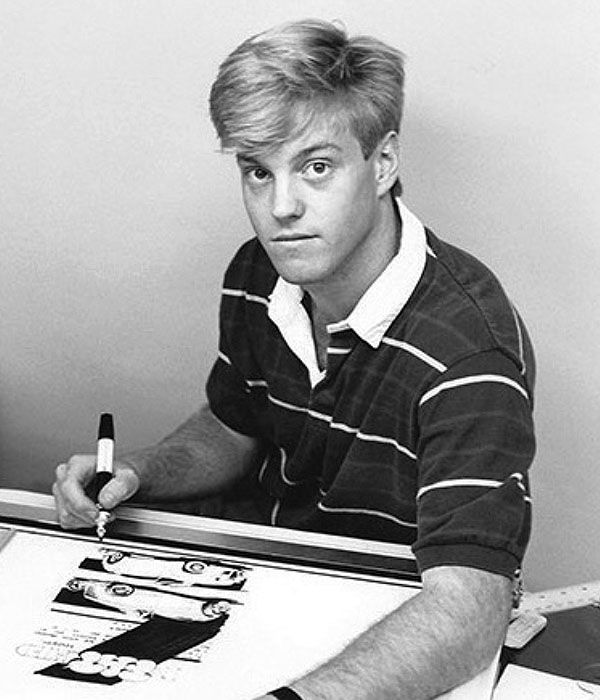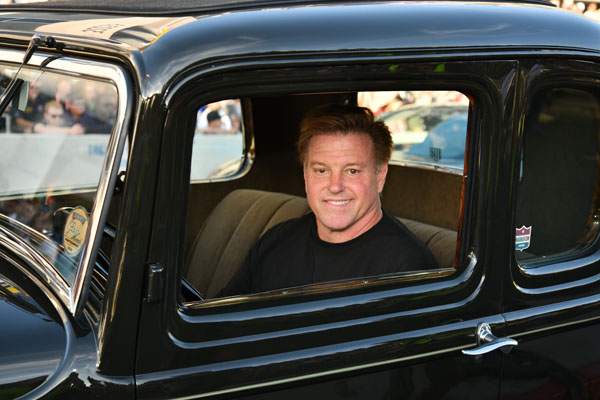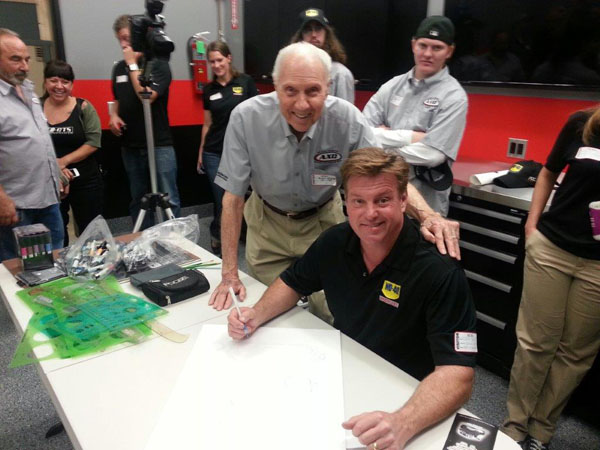2016 SEMA Hall Of Fame Inductee

Chip Foose
Foose Design
Chip Foose isn’t writing his autobiography (yet), but if he were, the first line might read, “My career is an extension of my father’s.” That’s because the earliest memories this well-regarded designer and acclaimed builder of custom vehicles has are, of course, car-related.
Douglas Sam Foose was born in Santa Barbara, California, and had “huge cheeks.” That made his mom instantly begin calling him Chipper or Chip, like a chipmunk; it wasn’t until day four that “Douglas” appeared on his birth certificate.
His first memory of the automotive industry was linked to his father, Sam, whose career in the 1960s and early 1970s took him from building high-profile Hollywood studio cars and hovercrafts to a company that did government safety testing and developed safety equipment, including airbags. Sam eventually went on to open his own shop, called Project Design. By the age of seven, Chip was already a fixture there.
“I like to think I was helping my dad, but I think I destroyed a lot more than I actually helped,” he said.
Age seven was also a big year in Foose’s life, because he met Alex Tremulis, designer of vehicles such as the Tucker. Tremulis was working with Sam, and when Chip saw his designs, “even at that age, I knew I wanted to go to ArtCenter College of Design and design cars for a living. I didn’t know who he was, but I absolutely fell in love with his artwork.”
Drawing was actually nothing new to Foose—he was already at it by age three.
“My father was a talented artist himself, and he would draw at home and I would sit next to him and copy whatever he was doing,” Foose recalled. “When he was finished, I would copy it and draw it over and over. My goal was to be as good as him.”
By the age of 14, he was that good, so when Sam had a design idea, he had Chip draw it.
As a youth, Foose played football, ran track, and did freestyle BMX—wheelies and jumping were his skills—but he was most passionate about design and remembers when he knew.
“I was 11, and my father was building a family van, and we were custom painting it,” he explained. “He wanted to add some curves to the panels, and I was crying because I didn’t want him to do it. I was emotional about what we were doing design-wise.”
As Foose got older, he became more hands-on at Sam’s shop, as an apprentice to various employees and also doing “lot of sanding for years and years. And I remember I’d waste so much paint just making colors, because I loved mixing. He had a mixing room, so I’d just go in there and put colors together.”
Foose did make it to ArtCenter on a small scholarship, but had to leave halfway through because he couldn’t afford the tuition. He was still working with his father, but he had also started his own business—a design studio, doing illustrations for magazines, until one of his part-time clients became a full-time job: Stehrenberger Design. While Foose worked for the company, he also began dating his future wife, Lynne. When the topic of marriage came up, she said he had “potential,” but she wanted a husband with a college degree.
Returning to ArtCenter, Foose’s senior project was creating a Chrysler-sponsored niche-market vehicle.
“I did something completely taboo at ArtCenter—looked at the past,” he said. “We were taught to only look forward. In this case, I blended hot rods and musclecars to create what I called the Hemisphere.”
That taboo design became the inspiration for the Plymouth Prowler. Foose was only 26. Boyd Coddington saw his potential too and hired him to do some work. “It was my hobby, so I never even gave a bill to Boyd for two and a half years,” Foose said.
Soon, he had a job offer from Ford and another from J Mays, who wanted Foose on the Beetle’s redesign team.
“I was deciding between Ford and Volkswagen, and I let Boyd know I was leaving, but then he made me a better offer than both of them did,” Foose said. He worked with Boyd for eight years until the company folded.
“I remember the final day, we had just loaded everyone’s toolboxes, and I had made sure the customers’ cars got to different shops and that everyone at Boyd’s shop had a job,” Foose said. “I was the only one who didn’t have a job. I had $700 in the bank and a $1,500 house payment due. That same day, my wife handed me a paper bag, and inside was a tiny T-shirt that read, ‘I love daddy,’ because she was pregnant. So that was the day we started Foose Design.” Again. “It’s been a roller coaster ever since, but I wouldn’t trade it for anything.”
Foose Design had been building cars for about two years when Foose was approached about doing a new reality show called “Monster Garage,” starring Jesse James. “They told me the first car was going to be a Mustang turned into a lawn mower,” he said. “But I’m trying to build rolling art, so I didn’t see the value. It was the best ‘no’ I’ve ever given.”
The Discovery Channel then decided it wanted to do a show about Foose building a new 2002 Ford Thunderbird for the SEMA Show. His drawings equated to a four-month build, but the car didn’t arrive until the 11th hour.
“I would work 40 hours straight, then sleep for eight, then another 40 hours,” he recalled. “I did that for six weeks, and the last six days were no sleep. I lost 27 pounds building that car.”
But he made the deadline, and J Mays, then with Ford, awarded it Best in Show. Out of the experience was born the television show “Overhaulin’,” which debuted in 2004.
Foose has always made time for charitable work, whether it’s to sign a T-shirt for auction, build Pinewood Derby cars or volunteer with Childhelp and Victory Junction Gang Camp. Also close to his heart is raising funds for Progeria, a disease that took the life of his younger sister, Amy, at age 16. Foose serves as the vice chairman of the Progeria Research Foundation’s California chapter.
His decades of unique work have been lauded many times over. He has won the Ridler award, the America’s Most Beautiful Roadster award, the Good Guys Trendsetter award, and inductions into the Grand National Roadster Show Hall of Fame, the Detroit Autorama Circle of Champions, and the Hot Rod Hall of Fame—its youngest inductee at the time.
And now, he’s being inducted into the SEMA Hall of Fame.
“It’s quite an honor, but it also makes me feel like I’m getting old! But to be honored in the SEMA Hall of Fame—that’s where all my heroes are,” Foose said. “If you look at the inductees, they followed their passions as well. They didn’t get into this for the money. They got into it because they loved it. We all have that in common.”
And what might the final sentence of his autobiography read? “Thank you,” Foose said, “to everybody who gave me the opportunities.”




